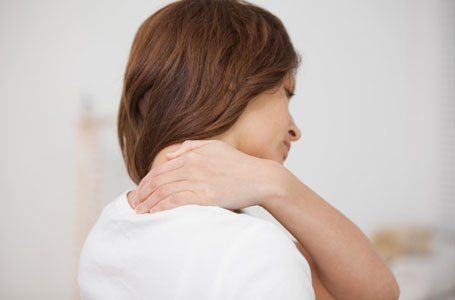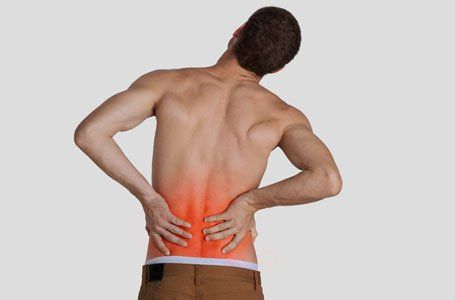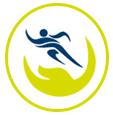Are you suffering from back pain?
Back pain is common with about nine out of ten adults experiencing it at some point in their life, and five out of ten working adults having it every year

Don't suffer with back pain! Give Mark a call … you won't regret it.
Types of back pain include:
- Lower Back Pain
- Upper Back Pain
- Acute Back Pain
- Chronic Back Pain
- Sciatica

Upper back pain treatment at Active Care Clinic
Upper back pain may also be known as a stiff neck. It is a form of back pain or spinal pain which is a much less common problem than lower back pain. Nevertheless, when it occurs, pain in the upper part of the spine can make the neck and shoulders stiff and uncomfortable, limiting movement.
Like lower back pain, there are many causes of pain in the upper back and often, the precise origin of the pain is not always clear. Mechanical disruption of joints and muscles of the neck and shoulders are perhaps the most common ‘non-specific’ causes, followed by muscle or joint injuries.
Sometimes, upper back pain or a stiff neck can give rise to headaches, particularly if the pain is in the neck.
Just as with pain in the lower back, upper back pain can be the result of a number of different factors. These range from something as simple as bad posture, to sudden injury or trauma.
Muscular injury or joint disruption (inflammation)
– this is the most likely cause of upper back pain. Muscular injury most often occurs in the muscles around the shoulder. The main joint of the shoulder, the glenohumeral joint, connects the upper arm with the torso. This joint is arguably the most manoeuvrable in the whole body – but this feature also makes it the most unstable. To compensate for this vulnerability, the shoulder is made up of a number of strong muscles which support the joint, but allow it a wide degree of movement. These muscles cover the upper back and shoulder, and are very prone to injury which can, in turn, lead to pain.
Lifestyle factors
– there are certain factors in your life which may contribute to your upper back pain, by repeatedly stressing one area of your back. These factors include:
- Not enough exercise, or exercising too much with the wrong technique
- Being overweight
- Sitting for too long, particularly with incorrect posture
- Lifting heavy objects
- Continually high levels of stress
Other causes
– there is a range of medical conditions which may result in upper back pain. Most of these include problems with the spine, including a slipped disc, trapped nerve, rheumatism or ‘wear and tear’ arthritis of the spinal joints in the neck and thoracic (chest) vertebrae.

Lower back pain treatment at Active Care Clinic
Pain in the lower part of the back is commonly referred to as Lumbago. It can be defined as mild to severe pain or discomfort in the area of the lower back. The pain can be acute (sudden and severe) or chronic if it has lasted more than three months.
Most people will experience lumbago at some point in their life. It can occur at any age but is a particular problem in younger people whose work involves physical effort and much later in life, in the elderly. In most cases it settles in a few weeks but for some it is a persistent problem.
What causes lower back pain?
In the majority of cases, it is impossible to identify the exact cause of low back pain.
There may, for example, have been tiny strains or tears of some of the small muscles and ligaments, which can be difficult to pinpoint within the complex structure that is the human back.
In about 25 per cent of cases, however, a specific problem can be found. Often, these patients are suffering from conditions like arthritis of tiny joints called facet joints between the vertebral bones, a slipped disc (prolapse of an intervertebral disc), a collapse or fracture of one or more vertebrae (this is more likely in older patients especially when they have fallen or there is osteoporosis or brittle bones), deformation of natural spine curvature (scoliosis) or more rarely, skeletal damage due to tumours or infection.
What are the symptoms of lumbago?
Pain across the lower part of the back that sometimes radiates into the buttocks, the back of the thigh or to the groin. The pain is usually worse on movement.
Limitation in movement of the spine – especially bending forward and leaning back.
Tense spasm of the muscles surrounding the spine and causing a stiff back.
With severe pain and spasm, the back may tilt to one side causing a change in posture or a limp.
The pain is sometimes accompanied by a tingling sensation or numbness in the back or buttocks or leg, which may pass right down into the foot. This is called sciatica, and it indicates irritation of the sciatic nerve, which passes down from each side of the spine to the feet.

‘Mark fixed my lower back problems which I had for such a long time in only 3 sessions and gave me loads of great stretches to do at home. Great service, would definitely recommend!’
- Lisa Pichl

'Me and my wife have booked another 6 sessions. The results of the changes in our postures is incredible! Don't suffer with back pain! Give Mark a chance … you'll be happy.'
- Leon David Preistly

'Fantastic clinic located near Piccadilly. Excellent service from a very professional clinician. Looking forward to my next treatment. Many thanks to Mark! Magic man.'
- Claire Jane Johnson

For professional back pain treatment in Manchester, get in touch with Active Care Clinic on 0161 637 2930

